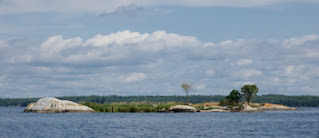 |
| Voyageurs National Park |
We crossed into the Lower 48 on Sunday at Warroad, Minnesota. It felt great to be back in the old U.S. of A. We had four days to play before our scheduled visit to David's mom, sister, and her husband. What to do?
While studying the Minnesota map, we had found an intriguing green area... Voyageurs National Park. We had never heard of it. Our road atlas indicated that it is one of the least visited of our national parks. The park is situated on the northern border of Minnesota and Canada on Lake Kabetogama, just west of the Boundary Water Canoe Area Wilderness. David had once dreamed of being a park ranger, canoeing the boundary waters between the States and Canada. It looked like the perfect spot for us to end this year's camping adventure.
By the time we arrived at the Rainy Lake visitor's center, it was closed. We quickly discovered that there were no campgrounds within the park accessible by car. In fact, the only way to get into the park is to travel by boat or plane. The nearest campground to us outside the park was Woodenfrog State Campground near Kabetogama. We drove there and found a lovely state park, heavily wooded and with lots of room between sites. It was the perfect launching place to discover more about the area.
Voyageurs National Park is named after the French-Canadian canoemen who ferried trade goods across these waters during the late 1700s and early 1800s. The surrounding landscape includes boreal forests that meet and mix with northern hardwood forests. It is home to a wide variety of wildlife, including bear, eagle, beaver, otter, moose, and the elusive timber wolf.
We visited the Ash River Visitors Center the following morning to learn more about the park. The ranger suggested we either rent a boat or take a water taxi to Kabetogama Peninsula. Unfortunately, the park's water shuttle service was booked until Thursday. The park's shuttle drops visitors off at the only motel lodging within the park... the historic Kettle Falls Hotel. The shuttle also offers visitors access to the peninsula's 52 miles of hiking trails.
We spent the rest of the day visiting a few boat rental places, finding the best deal at the Arrowhead Lodge. Then we took a much-needed hike on the Echo Bay trail loop.
The following morning, we arrived at Arrowhead Lodge and rented our aluminum fishing boat. The kind owners suggested that we head toward Cutover Island, circle around, and visit the Ellsworth Rock Garden.
As we left the marina, we saw two children diving from one of the floating docks.
On one of the little rock islands, we spied pelicans, gulls, and several cormorants drying their wings.
 |
| Birds gather on a rock island, Voyageurs National Park |
We docked at the historic sculpture gardens about an hour later. Jack Ellsworth built these gardens between 1944 and 1966. He took a 60-foot-tall granite outcropping, created dozens of rock and wooden sculptures, and accented the area with flowers. After his death, the gardens fell into disrepair. Deer now graze on the remaining lilies, however, the park has acquired the grounds and has begun restoring the gardens.
 |
| Ellsworth Rock Gardens, Voyageurs National Park |
 |
| Arrowhead sculpture, Ellsworth Rock Garden |
 |
| Teepee sculpture, Ellsworth Rock Garden |
We had the option of renting the boat for a half or full day. After about three hours, the skies made the choice for us. Heavy clouds began to gather and the wind began to rise. We made it back to the marina just minutes before it began to rain.
What a great place! Voyageurs is definitely a park we want to visit again. We can just imagine having a water taxi take us and kayaks out to one of the island campsites so that we can paddle around, looking for animals or fishing. Or perhaps we can entice friends and family to join us and rent a houseboat for several days. Or maybe we will even stay at the Kettle Falls Hotel and hike the trails along the peninsula.
Voyageurs is just our kind of place... cool temperatures during the day (even in August!), few visitors, and lots of water.
 |
| Lilies, Ellsworth Rock Garden |














